Chapter 14: Evidence-Based Teaching Practices
Learning Objectives
- Describe the rationale behind using evidence-based teaching practices.
- Identify and explain the impact of retrieval learning, spaced learning, and distributed practice on student outcomes.
- Apply evidence-based strategies to classroom scenarios to support student learning and metacognition.
Why Use Evidence-Based Practices?
“Teaching is facilitated or hampered by different strategies in learning” [1]. What students do, the strategies that they use, make a difference in how much learning takes place. However, students “often have a faulty mental model of how they learn and remember, making them prone to both misassessing and mismanaging their own learning” [2]. Students need help in improving their abilities to learn – and what teachers do, the strategies they use, makes a difference. “Learning is enhanced or impeded by different instructional strategies” [3]. Project Illuminated highlights a few selected evidence-based teaching practices in its materials and workshops. These strategies are inexpensive to use (time, resources, effort), align with the science of learning (e.g. our understanding of how learning happens), and contribute to developing student metacognitive skills [4]. Namely, these strategies both help students learn and can help correct ineffective study habits such as cramming, rereading, and inadequacy of practice. The primary strategies of focus in Illuminated are retrieval learning which involves having learners try to reconstruct what they’ve learned from their memories, distributed practice which involves spacing the reviews of learning over time, and spaced learning which involves repetition and active breaks during a learning session.
Why is it important that we choose evidence-based practices? Because teaching strategies make a difference!
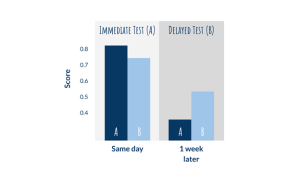
The learning design decisions educators make impact student learning. Below are some examples taken from SOL empirical studies – studies that go beyond behavioral, observational, and learning assessment data and align their findings with our understanding of how the brain operates (i.e. consistent with our current understanding of the structural and functional properties of the brain). Note that the examples of retrieval learning, distributed practice and spaced learning are further elaborated on in the subsections that follow. Retrieval learning led to a 49% increase in test scores across students by changing the type of practice activities students performed (e.g. by having students practice “taking information out” rather than “putting information in”) [5]. Distributed practice led to a 35% increase in student test scores. There was no increase in time spent learning, distributed practice just changed the schedule of when material was presented [6]. Spaced learning was shown to lead to a 14% increase in students’ final test scores – this was achieved by changing how the content within a single lesson was presented [7]. Additional strategies have been integrated into the design of the Illuminated workshops including pause procedures which involve explaining what you’ve learned to a partner [8]; self-explanations which involve explaining what you’ve learned to yourself [9]; drawing to remember which involves representing key concepts visually and drawing them out to enhance learning [10]; and peer instruction which involves having students in lecture settings efficiently debate critical concepts [11]. All of these strategies are cheap to use. They don’t require special technologies or applications, nor do they require additional classroom time [12].
Critical Thinking
- As a future teacher, how will you balance your personal teaching style and instincts with the need to use strategies that are backed by research?
- What challenges or benefits do you anticipate in making evidence-based decisions in your classroom?
Spaced Learning
Previously, we introduced long-term potentiation (LTP) as a mechanism that makes the connections among brain cells more permanent. LTP is the process of synthesizing or creating proteins in the synapses (connections between brain cells) to make them more permanent. Previously, many believed that long-term memory formation took days or longer to form in humans. However, more recent research suggests that LTP can be triggered in a short period of time by a specific pattern of activation [13]. The pattern, much like a recipe, was three ‘activations’ separated by two 10-minute gaps. “New research into the neuroscience of learning has now identified how long-term memories can be made in minutes rather than days and for complex topics, not just basic associations” [14].
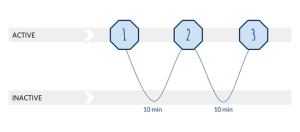
What would happen if such a pattern was applied in a formal educational setting? Kelley and Whatson (2013) applied this recipe (and called Spaced Learning) in a study conducted with high school students (age 13-15) in the United Kingdom. Students were enrolled in a national curriculum biology course and were randomly assigned to one of three groups (N = 1700+). Group A completed 4 months of regular biology lessons (23 hrs of direct instruction). Their final lesson was a standard 1-hour review class. Group B completed a single, 1-hour lesson (1 hour of direct instruction). All the material for the course was condensed into the single lesson that followed the Spaced Learning pattern. Group C completed 4 months of regular biology lessons (23 hrs of direct instruction). Their final lesson was a Spaced Learning 1-hour review class. Five days after each group’s review sessions, all students took a standardized national test on biology. What were the results of the study? Group B performed as well as Group A despite experiencing 22 fewer hours of instruction. Group B had 1 day instead of 4 months of study. Yet, Group C performed best of all. The class average increased by over 7 points just by modifying the design of the review class. So, if you teach courses, perhaps, consider spaced learning for the first and/or last lesson to better support students in forming LTM.
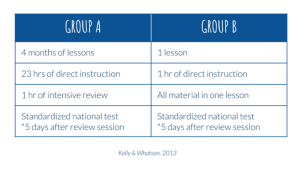
What could a Spaced Learning lesson look like? (1) The teacher presents key facts or information for 20-30 minutes. (2) Students are given a 10-minute active break. (3) Students review and recall the previously presented key facts/information. (4) Students are given a second 10-minute active break. (5) Students recall and apply the key facts/information. For the approach to work, it is believed that during the 10-minute breaks, the brain networks previously activated have to be inactive. Thus, rather than having a ‘free’ break, students complete a type of distractor activity. Something completely different that occupies their mind so they cannot go back to the previous learning. These activities could be drawing/pictionary, making models out of plaster, going for a walk in nature, etc.
Vigilance and Learning
When applying Spaced Learning we may want to choose a “fun” activity. According to the Yerkes-Dodson Law or inverted u-curve (see Figure 1), if our level of arousal (i.e. alertness) is too low we cannot perform (learn) well on challenging tasks. Moreover, if our level of arousal is too high (i.e. we are stressed) we cannot perform (learn) well unless the task is simple. The ideal zone is in the middle [15]. However, sitting for a long time and listening, as many students do in classrooms, lowers our arousal levels. Physical movement, social activity, and a little fun works to increase arousal levels and can move us into a better zone for learning. Keeping the Yerkes-Dodson Law in mind can both help us select appropriate Spaced Learning break activities and also increase our awareness of the importance vigilance (or alertness) plays in learning. Vigilance, which relates to sustaining one’s attention, is “influenced strongly by factors such as fatigue, anxiety, and motivation” [16]. Moreover, nutrition [17], physical fitness [18], and, critically, sleep [19] affect our abilities to reach optimal vigilance and can be considered basic ingredients of good learning.
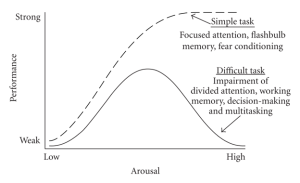
Critical Thinking
Spaced learning improves retention, but it often requires breaking lessons into shorter, repeated segments over time.
- How might you design instruction that uses spaced learning without losing student attention or disrupting engagement?
- What strategies could help maintain alertness during repeated exposure to content?
Additional reading on rapid long-term memory formation
- Pastötter, B., & Bäuml, K. H. T. (2014). Retrieval practice enhances new learning: the forward effect of testing. Frontiers in Psychology, 5, 286.
- Antony, J. W., Ferreira, C. S., Norman, K. A., & Wimber, M. (2017). Retrieval as a fast route to memory consolidation. Trends in cognitive sciences, 21(8), 573-576.
Distributed Practice
Spacing Effect and Distributed Practice
How should learning be scheduled? The key concept to know is the spacing effect which describes “the robust finding that long-term learning is promoted when learning events are spaced out in time, rather than presented in immediate succession” [20]. The spacing effect has been demonstrated in hundreds of studies since 1885 including the learning of facts, concepts, language, science, pictures, prose, and skill and motor learning such as typing, complex video games, and surgical skills [21]. Vlach and Sandhofer (2012) also found that the benefits of distributed practice are not limited to memory for specific information (e.g. facts or lists of words). Distributed practice also “promotes the acquisition and generalization of educational concepts.” Distributed practice is the learning strategy that takes advantage of the spacing effect by deliberately spacing out learning over time. Below are two studies that demonstrate the benefits of distributed practice (i.e. the spacing effect).
Study 1: Massed vs. Distributed Practice
In the study by Rawson and Kintsch[22][/footnote] (2005), students read a long text and took two tests – immediately after the learning session and one week after the last learning session (e.g. the last time the students read the text). Group A read the text twice in a row (same day). Group B read the text twice with one week in between readings. Both groups spent the same amount of time reading the text. The massed group (Group A) performed better on the immediate test. The distributed group (Group B) performed much better on the delayed test. Often, the results of immediate tests can trick us into believing that massing practice or cramming, which is the student version of massed practice, is a more effective strategy.
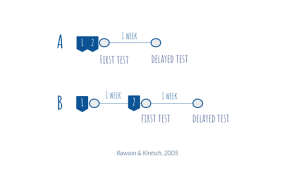
Study 2: Massed vs. Distributed Practice
High school students[23][/footnote] were taught French vocabulary and given a test 4 days later. Group A was taught in one 30-minute session. Group B was taught in three 10-minute sessions on successive days. There was a 35% advantage for distributed (Group B) over massed practice (Group A) – on the test taken 4 days later. This advantage was only due to changing how the learning was scheduled.
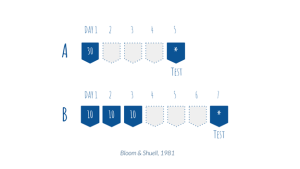
In sum, how we schedule learning activities matters. If we just want students to know the material for an exam, we can encourage massed practices. However, if we want them to keep what they’ve learned for a longer period of time then distributing their practice is critical. Moreover, it has been shown that “when retention intervals are measured at a week or greater, studies show that distributed practice nearly doubles recall performance [24]. ” So, with a slight alteration to how we schedule the presentation of important content, independent of how students study on their own, we can both improve student rates of learning and model to students a fundamental lifelong learning strategy.
Critical Thinking
- How are spaced learning and distributed practice different?
- Many students practice cramming over spaced-out reviews, even though research shows distributed practice leads to better long-term retention. As a future teacher, how will you design learning experiences or classroom routines that encourage distributed practice—and how will you help students value and adopt it?
Additional reading on the spacing effect and distributed practice
- Stahl, S. M., Davis, R. L., Kim, D. H., Lowe, N. G., Carlson, R. E., Fountain, K., & Grady, M. M. (2010). Play it again: The master psychopharmacology program as an example of interval learning in bite-sized portions. CNS spectrums, 15(8), 491-504.
- Bahrick, H. P. (1979). Maintenance of knowledge: Questions about memory we forgot to ask. Journal of Experimental Psychology: General, 108(3), 296.
- Hopkins, R. F., Lyle, K. B., Hieb, J. L., & Ralston, P. A. (2016). Spaced retrieval practice increases college students’ short-and long-term retention of mathematics knowledge. Educational Psychology Review, 28(4), 853-873.
- Rawson, K. A., & Dunlosky, J. (2011). Optimizing schedules of retrieval practice for durable and efficient learning: How much is enough?. Journal of Experimental Psychology: General, 140(3), 283.
- Vlach, H. A., Sandhofer, C. M., & Bjork, R. A. (2014). Equal spacing and expanding schedules in children’s categorization and generalization. Journal of experimental child psychology, 123, 129-137.
- Xue, G., Mei, L., Chen, C., Lu, Z. L., Poldrack, R., & Dong, Q. (2011). Spaced learning enhances subsequent recognition memory by reducing neural repetition suppression. Journal of cognitive neuroscience, 23(7).
Testing and Retrieval Learning
What type of activities have been shown to support durable learning in students? From a cognitive perspective, we can place learning activities into two broad categories: encoding activities and retrieval activities. Encoding related activities focus more on “putting information in” to long-term memory. Retrieval related activities focus more on “taking information out” of memory – i.e. practicing the extraction of information from our long-term memory. For example, when students listen to a teacher, read articles, watch videos, or create concept maps or write essays while looking at their notes, they perform encoding activities. These student actions are completed as part of putting information in memory accurately and elaborating on it. On the other hand, when students complete practice tests, write learning journals, instruct peers, or create concept maps or write essays from memory (e.g. without referring to their notes), they perform retrieval activities. As the student actions are completed without referring to their notes, they are required to retrieve the information from their memory system.
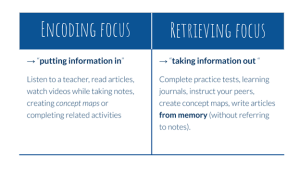
Empirical studies have found that students need to reconstruct memories and strengthen retrieval routes. A mix of encoding and retrieval activities are beneficial. As Bjork, Dunlosky & Kornell (2013) write, “to be a sophisticated learner requires understanding that creating durable and flexible access to to-be-learned information is partly a matter of achieving a meaningful encoding of that information and partly a matter of exercising the retrieval process.” But when comparing the efficacy of encoding versus retrieval types of activities, especially when reviewing material for tests, we see that retrieval activities are more effective in supporting durable learning. The results of such studies describe the testing effect. “Taking a test on material can have a greater positive effect on future retention of that material than spending an equivalent amount of time restudying the material, even when performance on the test is far from perfect and no feedback is given on missed information” [25]. The testing effect has been demonstrated in hundreds of studies since 1909 including studies on language learning, general knowledge, visuospatial materials, science, social science, statistics and in medical education. The studies have used real university exams, online testing, and in-class testing [26]. Below are two studies that demonstrate the benefits of retrieval learning (i.e. the testing effect).
Study 1: Encoding vs. Retrieval Practice
Students studied two TOEFL texts[27][/footnote] and took three tests at different times. The first was an immediate test after the last learning session, the next was after a 2-day delay, and the third was after a 1-week delay. Group A studied the text four times (study-only). Group B studied the text once (7-min) and then took 3 free recall tests without feedback. In other words, the students in Group B read the text once and then wrote down all they could remember about the text 3 times without being able to see if their writing was correct or not. Both groups spent the same amount of time studying. The study-only group (Group A) performed better on the immediate test (81% vs. 75%). The retrieval group (Group B) performed better on delayed tests (56% vs. 42%). The benefits of retrieval activities became more apparent the longer the delay. “The repeated-testing condition recalled much more after a week than did students in the repeated-study condition (61% vs. 40%), even though students in the repeated-testing condition read the passage only 3.4 times and those in the repeated-study condition read it 14.2 times.”

Study 2: Encoding vs. Retrieval Practice [28]
80 undergraduate students studied a science text and took a short-answer test (1 week later) with both verbatim and inference questions. Verbatim questions are recall questions of facts. Inference questions are more complex and require students to connect concepts within the text. Group A read the text and then created a concept map of the text. The concept map was created while reading the text. Group B read the text and wrote down all they could remember about the text (repeated twice) without referring to the text. There was almost a 50 percent increase for retrieval learning (M = 0.67) over concept mapping (M = 0.45) in conceptual learning in the test given a week later.
All in all, the type of learning activity we have students perform makes a difference. Interestingly, in Study 2 described above, even when the final test involved constructing a concept map, practicing retrieval during the original learning outperformed the group that practiced concept mapping [29].
Review & Practice
- What is the difference between retrieval and encoding activities?
- Why is distributed practice more effective than massed practice for long-term learning?
- What are the stages of memory according to the multi-store model?
Additional reading on the testing effect and retrieval learning
- Rawson, K. A., & Kintsch, W. (2005). Rereading effects depend on time of test. Journal of educational psychology, 97(1), 70.
- Bjork, R. A. (1988). Retrieval practice and the maintenance of knowledge. Practical aspects of memory: Current research and issues, 1, 396-401.
- Karpicke, J. D., Butler, A. C., & Roediger III, H. L. (2009). Metacognitive strategies in student learning: do students practise retrieval when they study on their own?. Memory, 17(4), 471-479.
- Koriat, A., & Bjork, R. A. (2006). Illusions of competence during study can be remedied by manipulations that enhance learners’ sensitivity to retrieval conditions at test. Memory & Cognition, 34(5), 959-972.
- Rawson, K. A., & Dunlosky, J. (2011). Optimizing schedules of retrieval practice for durable and efficient learning: How much is enough?. Journal of Experimental Psychology: General, 140(3), 283.
- Roediger III, H. L., & Pyc, M. A. (2012). Inexpensive techniques to improve education: Applying cognitive psychology to enhance educational practice. Journal of Applied Research in Memory and Cognition, 1(4), 242-248.
- Van den Broek, G., Takashima, A., Wiklund-Hörnqvist, C., Wirebring, L. K., Segers, E., Verhoeven, L., & Nyberg, L. (2016). Neurocognitive mechanisms of the “testing effect”: A review. Trends in Neuroscience and Education, 5(2), 52-66.
Media Attributions
- Studies often show that efficient learning strategies lead to longer lasting learning is licensed under a CC BY-SA (Attribution ShareAlike) license
- The Spaced Learning ‘recipe’ – three memory activations separated by two 10-minute breaks is licensed under a CC BY-SA (Attribution ShareAlike) license
- The Spaced Learning study design
- The Original Yerkes–Dodson law © Yerkes and Dodson 1908 is licensed under a CC BY-SA (Attribution ShareAlike) license
- Visual representation of a distributed practice study design involving reading comprehension is licensed under a CC BY-SA (Attribution ShareAlike) license
- Visual representation of a distributed practice study design involving language learning
- Common types of learning is licensed under a CC BY-SA (Attribution ShareAlike) license
- Visual representation of the retrieval is licensed under a CC BY-SA (Attribution ShareAlike) license
- Hascher, T. (2010). Learning and Emotion: perspectives for theory and research. European Educational Research Journal, 9(1), 13-28 ↵
- Bjork, R. A., Dunlosky, J., & Kornell, N. (2013). Self-regulated learning: Beliefs, techniques, and illusions. Annual review of psychology, 64, 417-444 ↵
- Hascher (2010) ↵
- Pashler, H., Bain, P. M., Bottge, B. A., Graesser, A., Koedinger, K., McDaniel, M., & Metcalfe, J. (2007). Organizing Instruction and Study to Improve Student Learning. IES Practice Guide. NCER 2007-2004. National Center for Education Research ↵
- Karpicke, J. D., & Blunt, J. R. (2011). Retrieval practice produces more learning than elaborative studying with concept mapping. Science, 331(6018), 772-775. ↵
- Bloom, K. C., & Shuell, T. J. (1981). Effects of massed and distributed practice on the learning and retention of second-language vocabulary. The Journal of Educational Research, 74(4), 245-248. ↵
- Kelley, P., & Whatson, T. (2013). Making long-term memories in minutes: a spaced learning pattern from memory research in education. Frontiers in human neuroscience, 7, 589. ↵
- Richards, L. W., Wang, A. T., Mahapatra, S., Jenkins, S. M., Collins, N. M., Beckman, T. J., & Wittich, C. M. (2017). Use of the pause procedure in continuing medical education: A randomized controlled intervention study. Medical teacher, 39(1), 74-78. ↵
- Bisra, K., Liu, Q., Nesbit, J. C., Salimi, F., & Winne, P. H. (2018). Inducing self-explanation: A meta-analysis. ↵
- Fernandes, M. A., Wammes, J. D., & Meade, M. E. (2018). The surprisingly powerful influence of drawing on memory. Current Directions in Psychological Science, 27(5), 302-308. ↵
- Mazur, E. (1997, March). Peer instruction: getting students to think in class. In AIP Conference Proceedings (Vol. 399, No. 1, pp. 981-988). AIP. ↵
- Pashler et al., 2007. ↵
- Fields, R. D. (2005). Making memories stick. Scientific American, 292(2), 74-81. ↵
- Ferguson, R., Barzilai, S., Ben-Zvi, D., Chinn, C.A., Herodotou, C., Hod, Y., Kali, Y., Kukulska-Hulme, A., Kupermintz, H., McAndrew, P., Rienties, B., Sagy, O., Scanlon, E., Sharples, M., Weller, M., & Whitelock, D. (2017). Innovating Pedagogy 2017: Open University Innovation Report 6. Milton Keynes: The Open University, UK. ↵
- Sapolsky, R. M. (2015). Stress and the brain: individual variability and the inverted-U. Nature neuroscience, 18(10), 1344. ↵
- Abernethy, B., Maxwell, J. P., Masters, R. S., Van Der Kamp, J., & Jackson, R. C. (2007). Attentional processes in skill learning and expert performance. Handbook of Sport Psychology, 3, 245-263. ↵
- Zeng, Y. C., Li, S. M., Xiong, G. L., Su, H. M., & Wan, J. C. (2011). Influences of protein to energy ratios in breakfast on mood, alertness and attention in the healthy undergraduate students. Health, 3(06), 383. ↵
- de Greeff, J. W., Bosker, R. J., Oosterlaan, J., Visscher, C., & Hartman, E. (2018). Effects of physical activity on executive functions, attention and academic performance in preadolescent children: a meta-analysis. Journal of science and medicine in sport, 21(5), 501-507. ↵
- Wright Jr, K. P., Hull, J. T., Hughes, R. J., Ronda, J. M., & Czeisler, C. A. (2006). Sleep and wakefulness out of phase with internal biological time impairs learning in humans. Journal of Cognitive Neuroscience, 18(4), 508-521. ↵
- Vlach, H. A., & Sandhofer, C. M. (2012). Distributing learning over time: The spacing effect in children’s acquisition and generalization of science concepts. Child development, 83(4), 1137-1144. ↵
- Roediger III, H. L., & Pyc, M. A. (2012). Inexpensive techniques to improve education: Applying cognitive psychology to enhance educational practice. Journal of Applied Research in Memory and Cognition, 1(4), 242-248. ↵
- [footnote]Rawson, K. A., & Kintsch, W. (2005). Rereading effects depend on time of test. Journal of Educational Psychology, 97(1), 70. ↵
- [footnote]Bloom, K. C., & Shuell, T. J. (1981). Effects of massed and distributed practice on the learning and retention of second-language vocabulary. The Journal of Educational Research, 74(4), 245-248. ↵
- Cepeda, N. J., Pashler, H., Vul, E., Wixted, J. T., & Rohrer, D. (2006). Distributed practice in verbal recall tasks: A review and quantitative synthesis. Psychological bulletin, 132(3), 354. ↵
- Roediger III, H. L., & Karpicke, J. D. (2006a). The power of testing memory: Basic research and implications for educational practice. Perspectives on psychological science, 1(3), 181-210. ↵
- Roediger III & Karpicke, 2006a ↵
- [footnote]Roediger III, H. L., & Karpicke, J. D. (2006b). Test-enhanced learning: Taking memory tests improves long-term retention. Psychological science, 17(3), 249-255. ↵
- Karpicke & Blunt, 2011. ↵
- Karpicke & Blunt, 2011. ↵

